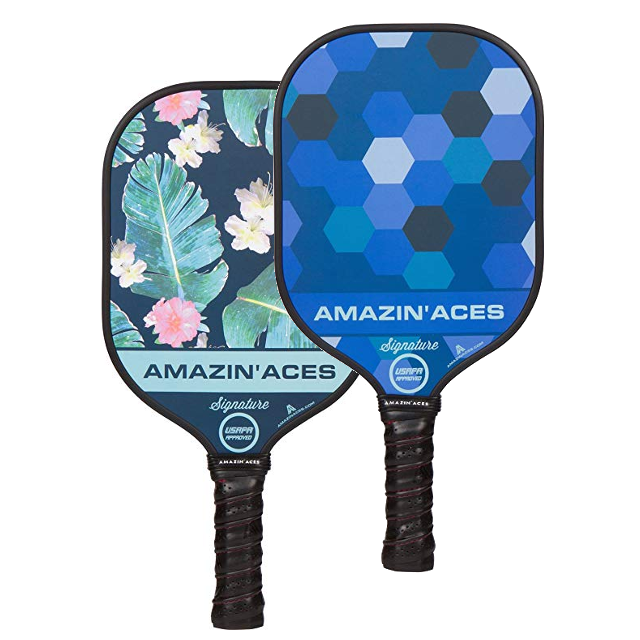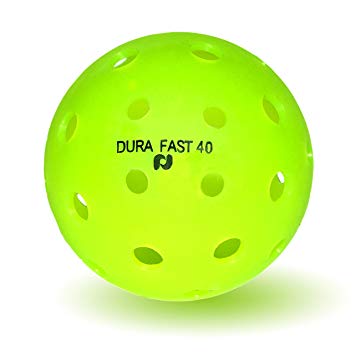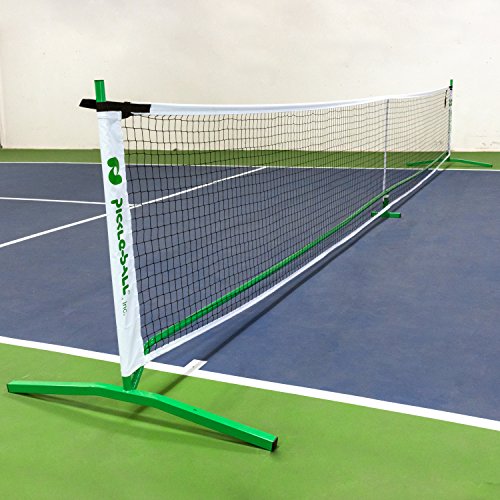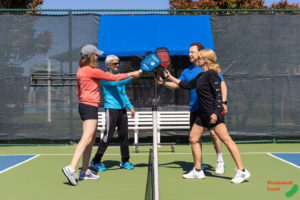Overview of pickleball Rules
Special paddles are required to play pickleball and it requires a badminton-sized court (20′ by 44′). Players hit a hollow plastic ball over a tennis-like net until one player fails to return the ball or commits a fault. Games are played as singles or doubles, but doubles are most popular.
The ball is served diagonally across the court like in tennis or ping-pong. Serves must be underhand. The ball may bounce once on your side of the court before the return. Players only score on their serve. Games are played to 11, win by 2.
After winning a point, the player who served continues serving, alternating sides. After a fault is committed, the serve rotates. If playing doubles, each player on a team gets to serve before the serving right moves to the opposing team.
If you are just starting out, these rules should be sufficient to get you playing pickleball and having fun. These are the simplified, easy-to-learn rules. For the official rules, check out the 2019 USAPA Rulebook [PDF].
Unique Pickleball Rules
Non-Volley Zone. One of the most distinctive features of pickleball is the non-volley zone (NVZ). This is the 7-foot region on either side of the net. Players cannot enter the non-volley zone to hit the ball unless the ball has already bounced in the NVZ. The non-volley zone is designed to prevent spiking.
The non-volley zone is sometimes called the kitchen. A volley is when a player hits the ball out of the air before it bounces on their side. A groundstroke is when the ball bounces first and then a player returns it.
Two-Bounce Rule. The serve and the first return must bounce. This is known as the two-bounce rule. After the first two strokes, players may volley the ball out of the air.
Court Size & Dimensions
Courts for Pickleball are 20 feet across by 44 feet long. The non-volley zone extends 7 feet on each side of the net. The court is divided in half by the center line. The centerline does not extend into the non-volley zone. There is no doubles-alley like in tennis. Singles and doubles play on the same court side.
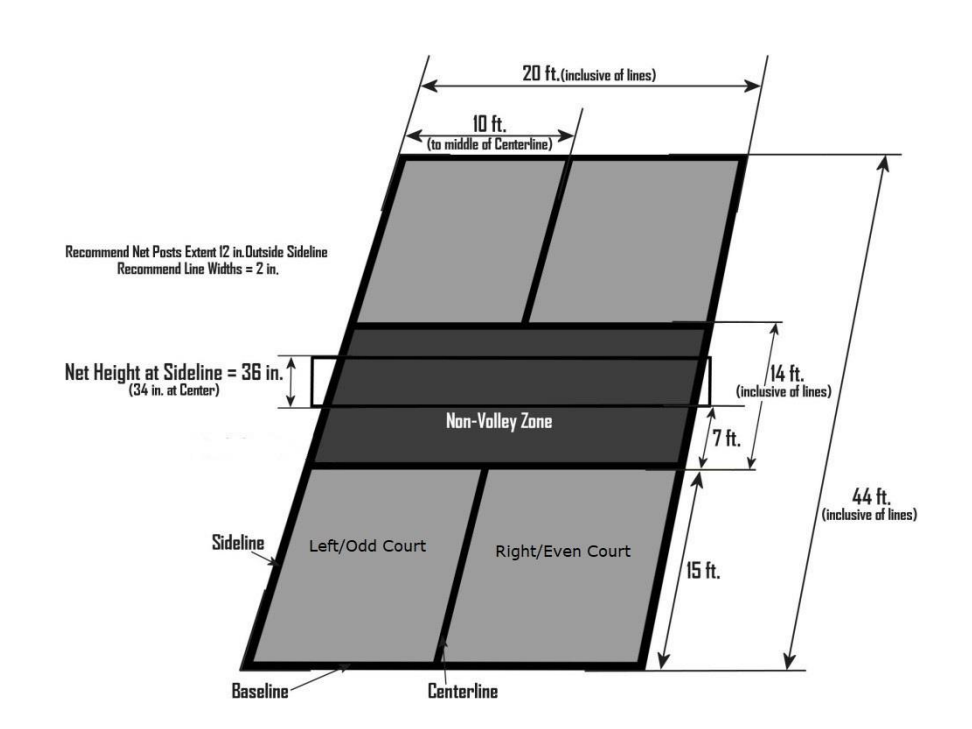
Equipment Requirements
Pickleball Paddles
The paddle for pickleball is larger than a ping-pong paddle and must be hard and smooth on both sides. The pickleball paddle is much lighter than a tennis racket. This means the game requires less arm and core strength than tennis.
The paddle cannot have holes. You can find pickleball paddles online or at your local sporting goods store. Not all commercially available paddles are USAPA Approved. Be sure to check if a paddle is approved before buying one if that is something you are worried about.
Pickleball Balls
The balls are made of hard perforated plastic much like a wiffleball and Pickleballs are bigger than a baseball but smaller than a softball. They are also lighter than a tennis ball which makes them easier to hit. If you come from a sport like tennis or ping-pong, you may be surprised by how little the balls bounce. This slows the game down and makes the game more about finesse than speed.
There are a variety of types of pickleball balls including indoor, outdoor, and quiet balls. Check out our complete guide to pickleball balls to learn more.
Pickleball Nets
The net in Pickleball is 36 inches high at the sideline and 34 inches in the center. The net is slightly lower than a tennis net which sits at 42 inches at the sideline and 36 inches in the center. The pickleball net should extend several feet outside the sidelines of the court.
Many casual players will use a tennis court to play pickleball due to their prevalence. You can tighten the center strap on a tennis court to lower the net slightly and make it closer to a regulation pickleball court.
In pickleball you may not touch the net. This is rarely a problem because the non-volley zone keeps players back away from the net.
*In the market for a net? Checkout Selecting the Best Pickleball Net
Pickleball Scoring Rules
Scoring for Pickleball is similar to badminton in that you can only score on your serve. A point is scored if the receiving team fails to return the ball or commits a fault. Typically, games are played to 11 and are won by 2 points. Occasionally games are played to 15 or 21.
Pickleball Serving Rules
Serves in pickleball must be underhand. The server stands behind either the left or right service court and serves diagonally into the opponent’s service court on the opposite side of the court.
A foot fault occurs if a player steps on the baseline or the imaginary extension of the centerline or sideline while serving. If a serve hits the net and still lands in the correct service court than it is a let and the play is repeated without penalty.
Before serving the ball the server must call the score. The score is called differently for singles and doubles. Player positioning also differs for singles and doubles. Player positioning is one of the most complicated parts of pickleball, particularly for doubles.
We also have a complete article on how to serve and serving strategies.
Singles Rules
Players serve until they commit a fault or fail to return the ball. After each point, the server switches sides between the right/even service court to the left/odd service court.
Player Position
When your score is even you serve from the right service court into your opponent’s right service court. When your score is odd you serve from left service court.
Calling the Score
Call the score as two numbers: your score followed by your opponent’s score.
Doubles Rules
Both players on a team get to serve before a sideout is called and the the serve switches to the other team. Each player serves, alternating service courts, until their team fails to return a shot or commits a fault. If your team wins a serve the player who served last continues serving.
For example, say player A and player B are on a team against player C and player D. Player A serves until her team commits a fault. Then player B serves until his team commits a fault. Next player C serves until his team commits a fault. Then, finally, player D serves until her team commits a fault.
The only exception is at the beginning of a game, the first team to serve only serves once before a sideout is called.
Doubles Player Position
Here are the key rules you need to know about serving positions for doubles:
- Each team must assign a first server and a second server.
- The first server serves from the right side when their team’s score is even and the left side when their team’s score is odd.
- The second server serves from the right side when their team’s score is odd and the left side when their team’s score is even.
- Serving always starts on the right side of the court after a sideout.
- The player who is correctly positioned based on the score (odd or even) will serve first for their team. So if a team’s score is even (0, 2, 4) after a sideout then the first server serves first from the right side of the court. If a team’s score is odd (1, 3, 5) after a sideout then the second server serves first from the right side of the court.
After reading all of this you might still be confused. That is okay. It is confusing! The “first server” servers first at the start of the game. After a sideout the first server serves first only if their team’s score is even. Otherwise the second server serves first.
Calling the Score in Doubles
Before the serve the server must call the score. In doubles, the score is called as three numbers:
- The first number is your serve number. If you are the first player to serve for your team you call “1” before each of your serves. The second player to serve calls “2” before each of their serves.
- Your second number is your team’s score
- Third number is the other team’s score
Line Call Rules
In general a ball that hits the line is considered in. The exception is on the serve. On a serve the ball must land within the service area without touching the non-volley zone line. The other lines are in.

All lines are two inches thick measuring from the outside of the line. For this reason, if a ball hits the line it is in. If a ball contacts the ground outside of the line it is out even if the ball over laps the line.
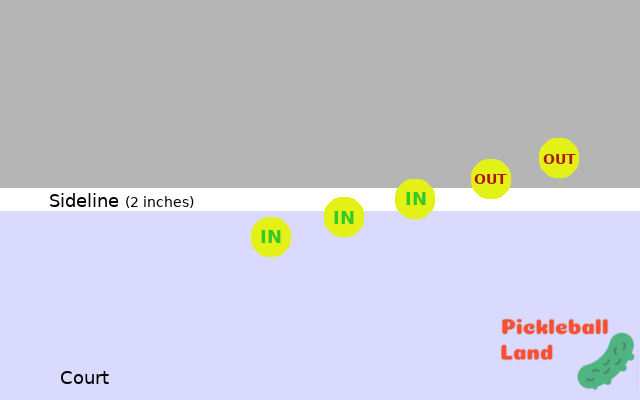
In tournament play there will be a referee and line judges to call lines. In casual play line calls are up to the players. If there is doubt about a call a “let” can be called and the rally repeated without penalty.
Pickleball Faults
A fault is any action that stops play due to a rule violation, including failing to return the ball. Most common faults include:
- Violating the double-bounce rule. Both the serve and the service return must bounce before being hit.
- Hitting the ball out of bounds
- Hitting the ball into the net
- Failing to hit the serve into the proper service court
- Failing to hit the ball before it bounces twice
- Touching the net
- Stepping into the non-volley zone before the ball has bounced on your side
- If a player or the player’s cloth touches the ball
- Failing to call the score before a serve
- Serving from the incorrect service court based on the score (odd or even) and your serve position (first or second). See doubles serving rules for more details.
Pickleball Etiquette & Rules of Conduct
Though pickleball is often played casually, it’s good to know the accepted etiquette before playing with others. Objectionable language or behavior is frowned upon and can result in a fault in tournament play. Paddle designs should be in good taste and not distracting to the opponent.
When making line calls, benefit of the doubt should go to the other team. If it is a critical point a let could also be called. If a ball cracks during play a let may be called if both players agree.
As all seasoned picklers know, the official hand shake of pickleball is the fist bump.
Pickleball Definitions
Check out the pickleball glossary for definitions to common pickleball terms.
Common Questions
What is the purpose of the two-bounce rule in Pickleball?
The two-bounce rule says that the ball must bounce on the serve and on the service return before being returned. At any other time the ball may be volleyed out of the air. This rule is designed to make it harder for players to approach the net.
Can you use your hands in Pickleball?
Using your hands is not allowed in pickleball. Players are only allowed to contact the ball with their paddle. If a player or any of their clothes touches the ball or net it is considered a fault. If the ball hits a player it is considered a fault by the player who was hit. Also, being hit by an outdoor pickleball ball hurts more than an indoor ball.
Do you have to win by 2 in Pickleball?
In pickleball you must win by two. Pickleball is most commonly played to 11. Sometimes games are played to 15 or 21.
Is there a Pickleball Ruling Body?
Yes, the ruling body in the US is the USAPA. Internationally there is the International Federation of Pickleball. Other official bodies include: Canadian Pickleball Association, Pickleball Spain, All India Pickleball Association, French Pickleball Association, Pickleball England, Dutch Pickleball Association, Italian Pickleball Association, German Pickleball Federation, China/Shenzhen Pickleball Association, Pickleball Association of Hong Kong, Chinese Taipei Pickleball Association, Korea Pickleball Association, Pickleball Association of Australia, and Pickleball Scotland.
What is a hinder?
A hinder is anything outside the game that interferes with play. For example, a dog running onto the court trying to catch the ball. A hinder results in a let being called and the rally is replayed.
Technical Fouls in Pickleball
In pickleball the referee can call a technical warning for unsportsmanlike conduct. The second technical warning in a game will result in a technical foul. A technical foul will result in one point being awarded to the other team. A second technical foul will result in the forfeit of the game.
Rules for three players
There are no official three player pickleball rules but playing 2-on-1 is not uncommon. With three players, the player playing by himself or herself should serve twice while the players on the other team each serve once-like in traditional doubles.
To keep the game fair you can also play that the 2-player team must return the ball to the side of the court the serve originated from. That way the single player only has to cover half the court.
Since Pickleball is growing in popularity, it’s easier to find a court than it was a decade ago. As it trends, you’ll also find more and more willing players and a very welcoming attitude. Get out and play!

